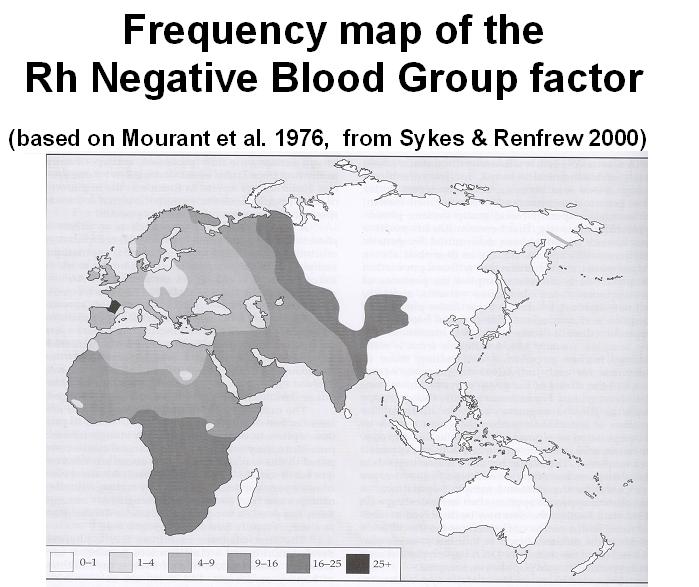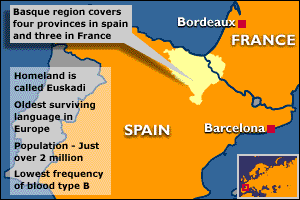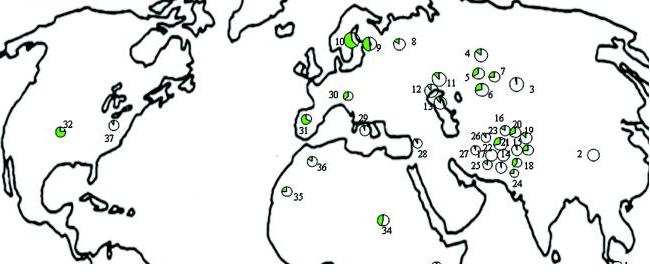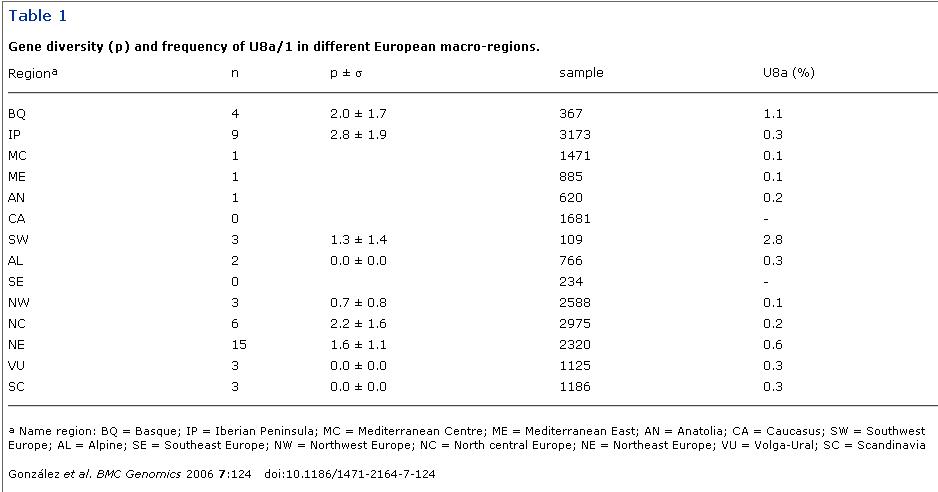About us
The Basque Marker R1b-M153 was only detected in Cerdana at 2.7% and Cinco Villas at 14.3% which are populations located in the Eastern and Western limits, respectively, of the examined Pyrenean area in this paper "In search of the Pre- and Post-Neolithic Genetic Substrates in Iberia: Evidence from Y-chromosome in Pyrenean Populations" by A.M. Lopez-Parra et al (2008). R1b-M153 has been exclusively detected in Iberians or Iberian descendants, and always at very low frequencies in non-Basque populations (Alonso et al. 2005, Flores et al. 2004).
Within the Basques studied by Alonso et al. (2005), R1b-M153 was found to be 11.1% in Basque from Biscay, 5.4% from Gipuzkoa and absent in Basques from Alava and Navarre. The authors further postulated that within Iberia the best candidate region for the origin of R1b-M153 was somewhere within or near to the Basque Country.
Two R1b-M153 haplotypes from Biscay were found to be molecularly very differentiated from any other lineage, which surely accounts for the large average variance across Y-STR detected in Biscay (0.388) compared to Cinco Villas (0.185). The detection of such divergent haplotypes can indicate that many intermediate R1b-M153 were either lost or still remained unsampled. The Time to Most Recent Common Ancestor of the dipicted lineages was estimated at 8,453 ±2711 years ago per the paper by by A.M. Lopez-Parra et al.
The Basque people are considered to be the closest remnants of a Paleolithic people that sought refuge in North Central Spain and Southwestern France during the Last Glacial Maximum (LGM) some 20 thousand years ago. They are unique in that they have: 1) the highest frequency of the Western Atlantic Modal Haplotype (WAMH) which is the most frequent haplotype in Western Europe.* Map of the frequency distribution of the R1*(xR1a,R1b3f)-M173 STR loci haplotypes in Europeans, Near East and North Africa. For clarity, only those haplotypes with a frequency above 2% are indicated. Populations: 1: Armenians (n=238); 2: Turkish (n=90); 3: Italians (n=20); 4: Berbers (n=23); 5: Non-Basque Iberians (n=437); 6: All Basques (n=209); 7: Croatians (n=34); 8: Austrians (n=42); 9: Germans (n=37); 10: Belgians (n=31); 11: Friesians (n=52); 12: Danes (n=77); 13: Norwegians (n=113); 14: Welsh (n=244); 15: Irish (n=285); 16: English (n=799); 17: Scottish (n=370); 18: Icelanders (n=75). Haplotype nomenclature refers to alleles of loci DYS19, DYS390, DYS391, DYS392 and DYS393 in that order. 2) among the highest frequency of Rh negative blood (updated research shows the others are Morocco, Ireland and Scotland).*
Map of the frequency distribution of the R1*(xR1a,R1b3f)-M173 STR loci haplotypes in Europeans, Near East and North Africa. For clarity, only those haplotypes with a frequency above 2% are indicated. Populations: 1: Armenians (n=238); 2: Turkish (n=90); 3: Italians (n=20); 4: Berbers (n=23); 5: Non-Basque Iberians (n=437); 6: All Basques (n=209); 7: Croatians (n=34); 8: Austrians (n=42); 9: Germans (n=37); 10: Belgians (n=31); 11: Friesians (n=52); 12: Danes (n=77); 13: Norwegians (n=113); 14: Welsh (n=244); 15: Irish (n=285); 16: English (n=799); 17: Scottish (n=370); 18: Icelanders (n=75). Haplotype nomenclature refers to alleles of loci DYS19, DYS390, DYS391, DYS392 and DYS393 in that order. 2) among the highest frequency of Rh negative blood (updated research shows the others are Morocco, Ireland and Scotland).* 3) the lowest frequency of B type blood who's origin (based on frequency) is East Asia.*
3) the lowest frequency of B type blood who's origin (based on frequency) is East Asia.* 4) erythrocytic enzymes and plasma proteins indicating that in these systems the Basques are also different from geographically neighboring populations.* 5) a non-Indo European language.* 6) the highest percentages of Lactase Persistence [along with a sampling from Utah (NW Euro)] in samples (31,32) from around the world.** This mutation allows milk tolerance which would have aided them during the Ice Age.
4) erythrocytic enzymes and plasma proteins indicating that in these systems the Basques are also different from geographically neighboring populations.* 5) a non-Indo European language.* 6) the highest percentages of Lactase Persistence [along with a sampling from Utah (NW Euro)] in samples (31,32) from around the world.** This mutation allows milk tolerance which would have aided them during the Ice Age. 7) Basques have the most ancestral phylogeny in Europe for the rare mitochondrial subhaplogroup U8a. Divergence times situate the Basque origin of this lineage in the Upper Palaeolithic.***
7) Basques have the most ancestral phylogeny in Europe for the rare mitochondrial subhaplogroup U8a. Divergence times situate the Basque origin of this lineage in the Upper Palaeolithic.*** Sources: *Are the Basques a Single and a Unique Population?. **Evidence of Still-Ongoing Convergence Evolution of the Lactase Persistence T-13910 Alleles in Humans. ***The mitochondrial lineage U8a reveals a Paleolithic settlement in the Basque country. If you have tested positive for M153 (a subclade of R1b) and would like to join this project click on the "Request to Join" link on the upper left hand side of this page and then click on "Join" to put in your request. Alternatively you can use the blue "Join" icon on your FTDNA pages. The project is under R in the Y geographical haplogroup projects.
Sources: *Are the Basques a Single and a Unique Population?. **Evidence of Still-Ongoing Convergence Evolution of the Lactase Persistence T-13910 Alleles in Humans. ***The mitochondrial lineage U8a reveals a Paleolithic settlement in the Basque country. If you have tested positive for M153 (a subclade of R1b) and would like to join this project click on the "Request to Join" link on the upper left hand side of this page and then click on "Join" to put in your request. Alternatively you can use the blue "Join" icon on your FTDNA pages. The project is under R in the Y geographical haplogroup projects.
Within the Basques studied by Alonso et al. (2005), R1b-M153 was found to be 11.1% in Basque from Biscay, 5.4% from Gipuzkoa and absent in Basques from Alava and Navarre. The authors further postulated that within Iberia the best candidate region for the origin of R1b-M153 was somewhere within or near to the Basque Country.
Two R1b-M153 haplotypes from Biscay were found to be molecularly very differentiated from any other lineage, which surely accounts for the large average variance across Y-STR detected in Biscay (0.388) compared to Cinco Villas (0.185). The detection of such divergent haplotypes can indicate that many intermediate R1b-M153 were either lost or still remained unsampled. The Time to Most Recent Common Ancestor of the dipicted lineages was estimated at 8,453 ±2711 years ago per the paper by by A.M. Lopez-Parra et al.
The Basque people are considered to be the closest remnants of a Paleolithic people that sought refuge in North Central Spain and Southwestern France during the Last Glacial Maximum (LGM) some 20 thousand years ago. They are unique in that they have: 1) the highest frequency of the Western Atlantic Modal Haplotype (WAMH) which is the most frequent haplotype in Western Europe.*
 Map of the frequency distribution of the R1*(xR1a,R1b3f)-M173 STR loci haplotypes in Europeans, Near East and North Africa. For clarity, only those haplotypes with a frequency above 2% are indicated. Populations: 1: Armenians (n=238); 2: Turkish (n=90); 3: Italians (n=20); 4: Berbers (n=23); 5: Non-Basque Iberians (n=437); 6: All Basques (n=209); 7: Croatians (n=34); 8: Austrians (n=42); 9: Germans (n=37); 10: Belgians (n=31); 11: Friesians (n=52); 12: Danes (n=77); 13: Norwegians (n=113); 14: Welsh (n=244); 15: Irish (n=285); 16: English (n=799); 17: Scottish (n=370); 18: Icelanders (n=75). Haplotype nomenclature refers to alleles of loci DYS19, DYS390, DYS391, DYS392 and DYS393 in that order. 2) among the highest frequency of Rh negative blood (updated research shows the others are Morocco, Ireland and Scotland).*
Map of the frequency distribution of the R1*(xR1a,R1b3f)-M173 STR loci haplotypes in Europeans, Near East and North Africa. For clarity, only those haplotypes with a frequency above 2% are indicated. Populations: 1: Armenians (n=238); 2: Turkish (n=90); 3: Italians (n=20); 4: Berbers (n=23); 5: Non-Basque Iberians (n=437); 6: All Basques (n=209); 7: Croatians (n=34); 8: Austrians (n=42); 9: Germans (n=37); 10: Belgians (n=31); 11: Friesians (n=52); 12: Danes (n=77); 13: Norwegians (n=113); 14: Welsh (n=244); 15: Irish (n=285); 16: English (n=799); 17: Scottish (n=370); 18: Icelanders (n=75). Haplotype nomenclature refers to alleles of loci DYS19, DYS390, DYS391, DYS392 and DYS393 in that order. 2) among the highest frequency of Rh negative blood (updated research shows the others are Morocco, Ireland and Scotland).* 4) erythrocytic enzymes and plasma proteins indicating that in these systems the Basques are also different from geographically neighboring populations.* 5) a non-Indo European language.* 6) the highest percentages of Lactase Persistence [along with a sampling from Utah (NW Euro)] in samples (31,32) from around the world.** This mutation allows milk tolerance which would have aided them during the Ice Age.
4) erythrocytic enzymes and plasma proteins indicating that in these systems the Basques are also different from geographically neighboring populations.* 5) a non-Indo European language.* 6) the highest percentages of Lactase Persistence [along with a sampling from Utah (NW Euro)] in samples (31,32) from around the world.** This mutation allows milk tolerance which would have aided them during the Ice Age.